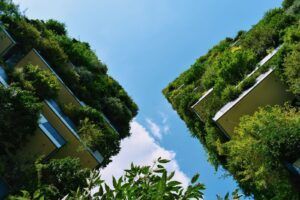
What Is Green Construction?
Green construction refers to the use of efficient and environmentally friendly resources and processes in construction. This ensures the building remains sustainable throughout its lifetime.
Primarily, the context in which the building will remain sustainable implies that the design, maintenance, repair, demolition, and operations all cause the least possible harm to the environment. The process to achieve this requires close collaboration between stakeholders.
The main areas of focus in building construction include:
- Efficient use of energy and resources
- Water preservation
- Reduction of pollution
- Durability
- Cost-effectiveness
Why Do We Need Green Building Technologies?
There are certain goals that need to be met if we are to reduce the effects of global warming, or at least prevent the planet from suffering even more.
These goals include:
- Reducing the use of energy and water
- Lowering our carbon footprint
- Improving the productivity of employees so as to eliminate the need for potentially harmful machinery.
How Can A Company Implement Green Construction Technology?
Implementing green construction technologies can range in levels of required effort, from changes that can be adapted immediately, to changes that require forward-planning and form part of a long-term sustainability strategy.
Go Paperless
In the construction office space, we use paper all the time. We print signs, lists, and work orders, sign documents, work on hard copies of documents and plans – the list goes on. However, there are ways around this. A vast portion of what was previously printed can be digitized, and companies can readily reduce paper use if they shift their focus.
Cloud and mobile software both offer companies the chance to reduce the use of paper, streamline operations and even cut costs. All data and documents can be stored on the cloud and accessed from anywhere. The use of mobile apps allows everyone from the foreman to the project manager and all other stakeholders to share data in real-time without having to print documents.
Invest In Smart Appliances
Commercial properties tend to consume a large amount of energy, but smart appliances change that. These devices are programmed to minimize the use of energy and are orientated to creating zero-energy buildings.
For example, a smart air conditioner won’t run full-time. Instead, it will monitor the temperature of a room or office space and only turn on when the temperature rises above a certain level. Construction companies can install smart appliances in their office and promote the use of them in every building they work on.
Harvest Solar Power
Solar power has become one of the most common sustainable energy solutions. It’s utilized in two ways: active solar power, which absorbs the sun’s radiation, and passive solar power, which relies on the sun’s rays to warm buildings through the strategic placement of windows and heat-absorbing surfaces.
Construction companies that switch to solar power not only help the environment and highlight their commitment to CSR, they also reduce long-term operational costs. It’s an excellent advertisement for clients too, as they can see the efficiency of solar power first hand.
The Real World Impact of Green Construction Technology
Green buildings can reduce or eliminate negative impacts on the environment by using less water, energy, natural resources, and improved air and water quality, reduced waste, and protected biodiversity and ecosystems.
According to the Global Alliance for Buildings and Construction (GABC), the building sector has the potential to make energy savings of 50% or more in 2050. This kind of commitment could limit global temperature rises to 2°C above pre-industrial levels.
A warming of 2°C across the whole globe has terrible knock-on effects for the societies and ecosystems living on the planet. Climate change is projected to be a poverty multiplier, which means that its impacts are expected to make the poor poorer and the total number of people living in poverty greater.
Besides environmental and social, the benefits of green buildings are financial.
There is a reduction in operating costs as green building technologies save money through reduced energy usage, water usage, and lower maintenance costs of the building. Green buildings also have higher building value as owners and developers can earn higher rents, and enjoy higher occupancy rates than non-green buildings. Investing in green buildings provides a quick return on investment and an increase in revenue.
Author Bio:

Rae Oliver is a freelance content creator. Her published work covers a vast range of topics, from SaaS to lifestyle and fitness. Like many other 20-something professional digital nomads, she has a passion for travel, social media, and digital marketing.











